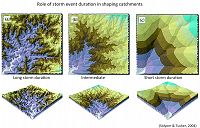CHILD
Channel-Hillslope Integrated Landscape Development (CHILD) model
Computes time evolution of a topographic surface z(x,y,t) by erosion (fluvial, hillslope) and sediment transport
Model Category: Numerical
-
Boulder, INVESTIGATOR
N. Gasparini - MIT
S. Lancaster - MIT
Quintijn Clevis - Oxford
And many more - various institutions
CHILD computes the evolution of topography and stratigraphy in response to erosion and sediment transport by gravitational, fluvial, and tectonic processes. The program is designed to provide a flexible and extensible platform for landscape evolution modeling, and it provides a wide range of options for representing runoff, regolith production and transport, fluvial erosion and transport, base-level variation, and tectonics.
The Channel-Hillslope Integrated Landscape Development (CHILD) model is a computer program written in C++ that calculates the evolution of topography and stratigraphic deposits in response to various geomorphic processes. The model represents the terrain surface using an unstructured grid of points based on a Delaunay triangulation. The height of each grid node evolves over time in response to erosion and sedimentation by processes such as soil creep and stream transport, and optionally in response to tectonic deformation. The program offers a broad range of options that allows the user to design many different types of model, by specifying spatial scale, time scale, and process laws. Climate is represented using a stochastic rainfall (storm) generator; the mean storm properties may be varied over time in order to represent changing climate. Water is routed downhill using a steepest-descent algorithm, and assuming either steady or "pulse like" channel discharge. Options for runoff generation include a simple constant infiltration capacity and a topographically dependent runoff threshold. Geomorphic process laws include regolith generation by physical and/or chemical weathering, regolith transport by linear or nonlinear creep, fluvial sediment transport with one or multiple grain size classes, and fluvial erosion of bedrock. The model can track stratigraphy in the form of a series of "layers" at each node; every layer is tagged with a time of deposition and optionally a grain-size composition. A simple vegetation growth and damage algorithm provides a means to explore interactions between vegetation and water erosion. For applications in tectonic geomorphology, the program provides a menu of tectonic deformation functions.
People: CHILD was originally developed by Greg Tucker (Boulder Creek CZO), Stephen Lancaster (Oregon State University), Nicole Gasparini (Tulane University), and Rafael Bras (Georgia Tech). Since then, CHILD continues to benefit, contributions by many researchers in the community.
Selected publications:
Model description and background:
Tucker, G.E., Lancaster, S.T., Gasparini, N.M., and Bras, R.L. (2001a) The Channel-Hillslope Integrated Landscape Development (CHILD) Model, in Landscape Erosion and Evolution Modeling, edited by R.S. Harmon and W.W. Doe III, Kluwer Academic/Plenum Publishers, pp. 349-388.
Tucker, G.E., Lancaster, S.T., Gasparini, N.M., Bras, R.L., and Rybarczyk, S.M. (2001b) An Object-Oriented Framework for Hydrologic and Geomorphic Modeling Using Triangulated Irregular Networks, Computers and Geosciences, 27(8), pp. 959-973.
Tucker, G.E. (2011) CHILD Users' Guide. (Available from CSDMS: http://csdms.colorado.edu/mediawiki/images/Child_users_guide.pdf)
Tucker, G.E., and Hancock, G.R. (2010) Modelling landscape evolution: Earth Surface Processes and Landforms, v. 35, p. 28-50.
Specific applications:
Tucker, G.E., and Bras, R.L. (2000) A Stochastic Approach to Modeling the Role of Rainfall Variability in Drainage Basin Evolution, Water Resources Research, 36(7), pp. 1953-1964.
Lancaster, S.T., S.K. Hayes, and G.E. Grant (2001) Modeling sediment and wood storage and dynamics in small mountainous watersheds, in Geomorphic Processes and Riverine Habitat, J.M.
Dorava, D.R. Montgomery, B.B. Palcsak, and F.A. Fitzpatrick (eds.), pp. 85-102, American Geophysical Union, Washington. Reprint
Bogaart, P.W., Tucker, G.E., and de Vries, J.J. (2003) Channel network morphology and sediment dynamics under alternating periglacial and temperate regimes: A numerical simulation study: Geomorphology, vol. 54, no. 3/4, p. 257-277.
Bras, R.L., Tucker, G.E., and Teles, V.T. (2003) Six myths about mathematical modeling in geomorphology: in Prediction in Geomorphology, edited by P. Wilcock and R. Iverson, American Geophysical Union, pp. 63-79.
Lancaster, S.T., S.K. Hayes, and G.E. Grant, 2003. Effects of wood on debris flow runout in small mountain watersheds, Water Resources Research, 39(6), 1168, doi:10.1029/2001WR001227.
Collins, D., Bras, R., and Tucker, G.E. (2004) Modeling the effects of vegetation-erosion coupling on landscape evolution: Journal of Geophysical Research - Earth Surface, v. 109, no. F3, F03004, doi:10.1029/2003JF000028.
Gasparini, N.M., Tucker, G.E., and Bras, R.L. (2004) Network-scale dynamics of grain-size sorting: Implications for downstream fining, stream-profile concavity, and drainage basin morphology: Earth Surface Processes and Landforms, 29(4), 401-422.
Solyom, P., and Tucker, G.E. (2004) The effect of limited storm duration on landscape evolution, drainage basin geometry and hydrograph shapes: Journal of Geophysical Research - Earth Surface, v. 109, F03012, doi:10.1029/2003JF00032.
Tucker, G.E. (2004) Drainage basin sensitivity to tectonic and climatic forcing: implications of a stochastic model for the role of entrainment and erosion thresholds. Earth Surface Processes and Landforms, 29, 185-205.
Istanbulluoglu, E., Bras, R.L., Flores-Cervantes, H., and Tucker, G.E. (2005) Implications of bank failures and fluvial erosion for gully development: Field observations and modeling. Journal of Geophysical Research - Earth Surface, v. 110, no. F1, F01014, doi:10.1029/2004JF000145.
Clevis, Q., Tucker, G.E., Lock, G., Lancaster, S.T., Gasparini, N.M., and Desitter, A. (2006) A simple algorithm for the mapping of TIN data onto a static grid: applied to the stratigraphic simulation of river meander deposits Computers and Geosciences, v. 32, p. 749-766.
Clevis, Q., Tucker, G.E., Lock, G., Lancaster, S.T., Gasparini, N.M., Desitter, A., and Bras, R.L. (2006) Geoarchaeological simulation of meandering river deposits and settlement distributions; a three-dimensional approach. Geoarchaeology, v. 21, no. 8, p. 843-874 (doi: 10.1002/gea.20142).
Flores-Cervantes, J.H., Istanbulluoglu, E., and R.L. Bras (2006) Development of gullies on the landscape: A model of headcut retreat resulting from plunge pool erosion, Journal of Geophysical Research - Earth Surface.
Gasparini, N.M., Bras, R.L., and Whipple, K.X. (2006) Numerical modeling of non-steady-state river profile evolution using a sediment-flux-dependent incision model, in Tectonics, climate and landscape evolution, S. Willett, N. Hovius, M. Brandon & D. Fisher, eds., GSA Special Paper 398, Penrose Conference Series, Geological Society of America, pp 127-141.
Crosby, B.T., Whipple, K.X., Gasparini, N.M., and Wobus, C.W. (2007) Formation of Fluvial Hanging Valleys: Theory and Simulation, J. Geophys. Res., 112, doi:10.1029/2006JF000566.
Gasparini, N. M., K. X. Whipple, and R. L. Bras (2007), Predictions of steady state and transient landscape morphology using sediment-flux-dependent river incision models, J. Geophys. Res., 112, doi:10.1029/2006JF000567.
Attal, M., Tucker, G.E., Whittaker, A.C., Cowie, P.A., and Roberts, G.P. (2008) Modeling fluvial incision and transient landscape evolution: Influence of dynamic channel adjustment. Journal of Geophysical Research - Earth Surface, v. 113, F03013, doi:10.1029/2007JF000893.
Fleurant, C., Tucker, G.E., and Viles, H.A. (2008) Modelling cockpit karst landforms. In: Gallagher, K., Jones, S.J., and Wainwright, J., eds., Landscape Evolution: Denudation, Climate and Tectonics over Different Time and Space Scales. Geological Society of London Special Publication 296.
Gasparini, N.M., Bras, R.L., and Tucker, G.E. (2008) Numerical predictions of the sensitivity of grain size and channel slope to an increase in precipitation. In: Rice, S.P., Roy, A.G., and Rhoads, B.L., eds., River Confluences, Tributaries and the Fluvial Network, John Wiley & Sons.
van Balen, R., Busschers, F., and Tucker, G.E. (2010) Modeling the response of the Rhine-Meuse fluvial system to late Pleistocene climate change: Geomorphology, v. 114, no. 3, p. 440-452.
Attal, M., Cowie, P.A., Whittaker, A.C., Hobley, D., Tucker, G.E., and Roberts, G.P. (2011) Testing fluvial erosion models using the transient response of bedrock rivers to tectonic forcing in the Apennines, Italy, J. Geophys. Res., 116, F02005, doi:10.1029/2010JF001875.
Explore Further



